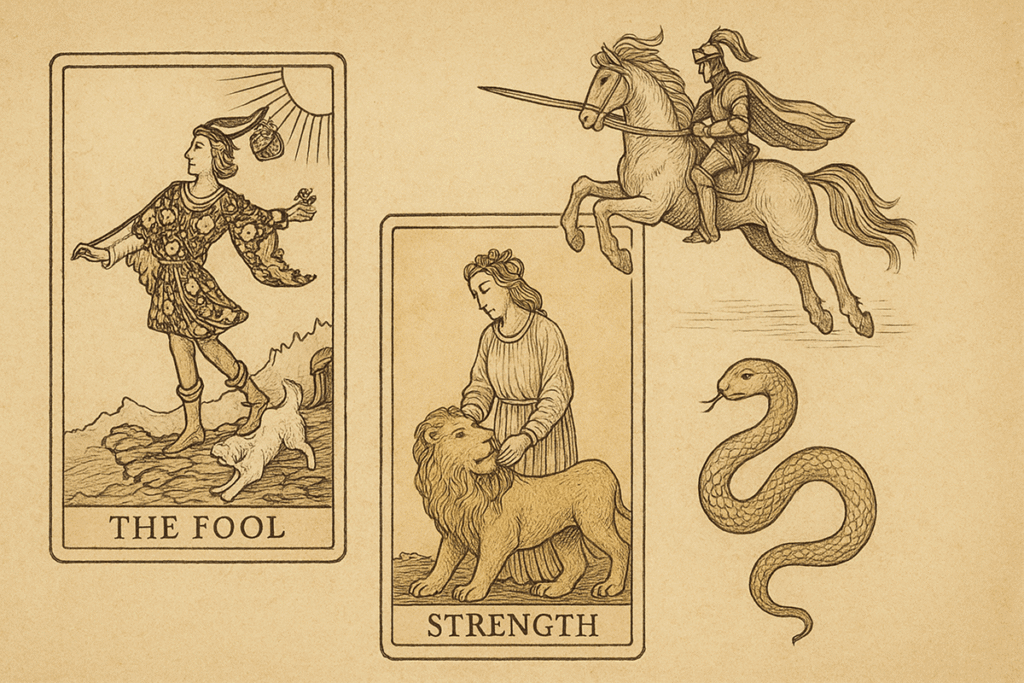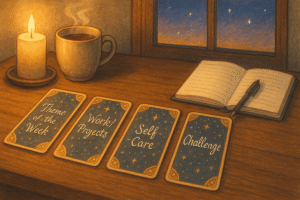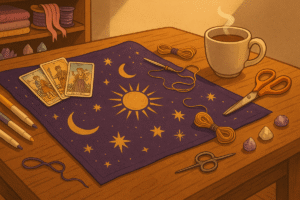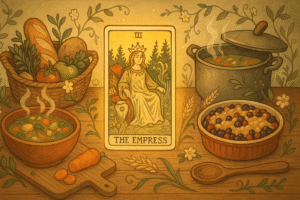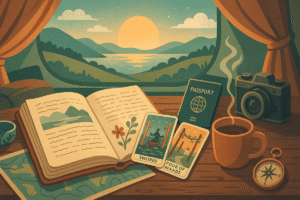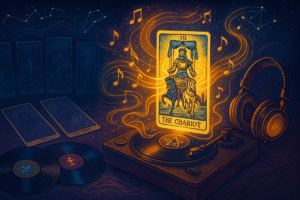Table of Contents
When I first started studying tarot seriously, I found myself drawn to the intricate details that Pamela Colman Smith wove into her illustrations for the Rider-Waite-Smith deck. Perhaps it was my background in art history, or maybe just natural curiosity, but the animals scattered throughout these cards fascinated me more than the human figures themselves. Each creature seemed deliberately placed, carrying centuries of symbolic weight that transforms how we might interpret these archetypal images.
The Rider-Waite-Smith deck, published in 1909, revolutionized tarot by including detailed imagery on every card, including the minor arcana. This artistic choice created a visual language rich with symbols, and animals play a crucial role in this symbolic vocabulary. Understanding these creatures and their traditional meanings can deepen our appreciation of the deck’s artistic heritage and cultural significance.
The Loyal Companion: Dogs in the Tarot
The most immediately recognizable animal companion appears in The Fool card, where a small white dog leaps alongside the figure stepping toward a cliff. In Western art and mythology, dogs have consistently represented loyalty, protection, and instinctive wisdom. This symbolism stretches back to ancient civilizations where dogs served as guardians of both the living and the dead.
In The Fool, the dog serves multiple symbolic functions. Art historians often point to the creature’s positioning as significant. Rather than pulling the Fool back from danger, the dog appears to be accompanying the journey with enthusiasm. This suggests that our instinctive nature, when properly aligned, supports rather than hinders our spiritual adventures.
The white coloring of the dog adds another layer of meaning. White animals in medieval and Renaissance art frequently symbolized purity and divine guidance. I think there’s something particularly touching about how Smith chose to make this companion so small yet so present in the composition. It reminds us that sometimes our most important guides come in humble forms.
Dogs also appear in other cards throughout the deck, including The Moon, where they take on more complex symbolic roles. In that card, two dogs or wolves howl at the moon, representing perhaps the dual nature of our instinctual responses: both protective and wild.
The Fierce Heart: Lions as Symbols of Courage
The Strength card presents us with one of the most powerful animal symbols in the entire deck: the lion. In this card, a woman gently closes or opens the mouth of a lion, demonstrating mastery through gentleness rather than force. The symbolism here draws from thousands of years of lion imagery in art and literature.
Lions have represented courage, nobility, and solar power across cultures. In medieval Christian art, lions symbolized both Christ’s resurrection and the devil’s power, depending on context. The ancient world associated lions with sun gods and divine authority. When we see the lion in Strength, we’re witnessing this entire symbolic heritage compressed into a single, elegant image.
What strikes me about Smith’s interpretation is the calm expression on both the woman’s and lion’s faces. There’s no struggle here, no violent conquest. Instead, we see what appears to be a moment of mutual understanding. The lion’s mane, rendered in golden yellow, catches the eye and reinforces the solar associations that have followed this creature throughout art history.
The positioning of the figures creates an intimate scene. The woman leans over the lion with care, and the lion allows this touch. Perhaps this suggests that true strength comes not from domination but from harmony with our powerful impulses.
Horses in Motion: The Knights’ Mounts
Each Knight in the minor arcana rides a different horse, and these steeds carry their own symbolic weight. Horses have represented movement, energy, and the connection between earthly and spiritual realms in cultures worldwide. In tarot, they amplify and reflect the energy of their riders.
The Knight of Wands rides a rearing horse, captured mid-leap. The horse appears almost to be dancing, its front hooves lifted high. This dynamic pose reinforces the impulsive, energetic nature associated with the fire element. The horse’s color, a warm reddish brown, echoes the fiery temperament.
By contrast, the Knight of Cups sits atop a calm, walking horse. The steady pace suggests emotional stability and measured progress. I’ve always found it interesting how Smith managed to convey personality through such simple details as posture and movement.
The Knight of Swords presents perhaps the most dramatic horse, charging forward with head lowered and mane streaming. This horse embodies pure momentum, the intellectual energy that can’t be stopped once it begins moving. The white color might suggest clarity of thought or pure mental energy.
The Knight of Pentacles offers the most grounded horse, sturdy and patient. This horse stands still, perhaps representing the earthy, practical energy that prefers careful consideration to hasty action. The horse appears well-fed and healthy, suggesting material stability.
The Transformative Serpent
Though less prominent than dogs, lions, or horses, serpents appear in several cards and carry profound symbolic meaning. The serpent has been a complex symbol throughout human history, representing everything from wisdom and medicine to temptation and transformation.
In the Wheel of Fortune, a serpent descends along the left side of the wheel, balancing the ascending figure on the right. This placement suggests the cyclical nature of life and fortune. The serpent’s downward movement might represent necessary descent before renewal, the shedding of old skin before growth.
The symbolism of serpents in Western esoteric traditions often focuses on transformation and hidden knowledge. The ouroboros, the serpent eating its own tail, represents eternal cycles and renewal. While not directly depicted in the Rider-Waite-Smith deck, this concept influences how we might interpret serpent imagery.
In medical symbolism, serpents represent healing and transformation, as seen in the caduceus and staff of Asclepius. The snake’s ability to shed its skin made it a natural symbol for renewal and rebirth across many cultures.
Birds as Messengers and Spirits
Various birds flutter through the Rider-Waite-Smith cards, each carrying distinct symbolic associations. In The Star, a bird perches in a tree, perhaps representing hope or spiritual messages. Birds have long been viewed as messengers between earthly and divine realms due to their ability to fly.
The ace cards often feature birds, particularly doves, which traditionally symbolize peace and divine inspiration. In Christian iconography, the dove represents the Holy Spirit, while in secular contexts, it suggests harmony and new beginnings.
Ravens and eagles appear in other cards, bringing their own mythological associations. Ravens connect to wisdom and prophecy in many Northern European traditions, while eagles represent power and divine authority in numerous cultures.
The Artistic Context
Understanding these animal symbols requires considering the artistic and cultural context in which Pamela Colman Smith created these images. She was working within established Western esoteric traditions while also drawing from her background in theater and illustration. The animals in her cards weren’t chosen randomly but selected for their rich symbolic heritage.
Smith’s approach to animal symbolism reflects the synthesis of various mystical traditions that characterized early 20th-century occultism. Her images blend Christian symbolism, pagan mythology, and popular folklore into a cohesive visual language that continues to resonate today.
The way these animals interact with human figures in the cards often suggests partnership rather than domination. This reflects changing attitudes toward nature and animals that were emerging during Smith’s era, moving away from purely hierarchical relationships toward more integrated understandings.
Reflecting on Animal Wisdom
When we encounter these animals in tarot readings, they invite us to consider what aspects of ourselves they might represent. The loyal dog might ask us to examine our own faithfulness to our path. The powerful lion could prompt reflection on where we need to find courage or where we might be using force instead of strength.
The horses of the Knights might encourage us to think about our own pace and direction. Are we charging ahead like the Knight of Swords’ mount, or standing still like the horse of the Knight of Pentacles? Perhaps we need to adjust our speed or change our approach entirely.
These animal symbols offer us a way to connect with the more instinctual aspects of human experience. In our increasingly digital world, there’s something grounding about contemplating the wisdom embedded in these traditional animal symbols.
What draws me back to studying these creatures again and again is their enduring relevance. Despite being created over a century ago, these animal symbols continue to speak to something fundamental in human psychology and experience. They remind us that we share this world with other forms of consciousness and intelligence, each offering its own form of wisdom for our consideration.
Frequently Asked Questions
Why doesn’t the Queen of Wands have a salamander when the other Wands court cards do?
The salamander appears on the Page, Knight, and King of Wands but not the Queen. Instead, the Queen features a black cat, lions, and a sunflower. This choice likely reflects the Queen’s more balanced and mature expression of fire energy, where the feminine intuition (symbolized by the cat) tempers the raw elemental force represented by salamanders.
What’s the difference between the lions on the Strength card and those on other cards like The World?
The lion in the Strength card represents personal courage and the mastery of our powerful impulses through gentleness rather than force. The lions on The World and The Wheel of Fortune are part of a tetramorph (a four-creature symbol) representing the four fixed signs of the zodiac and have different symbolic meanings related to cosmic order and completion.
Are salamanders actual lizards in the tarot imagery?
The creatures depicted are salamanders, not generic lizards. In medieval and esoteric traditions, salamanders were believed to be elemental fire spirits that could pass through flames unharmed. This mythological association made them perfect symbols for the fire element and the Wands suit, which is why they appear decorated on the clothing and thrones of the Wands court cards.

